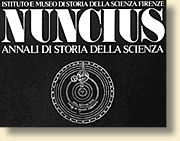
Institute and Museum of the History of Science, Florence, ITALY

1996/2
|
| M. MINIATI, A distanza di trent'anni. | pag.501 |
| W. R. SHEA, The Revelations of the Telescope. | pag.507 |
G. BARONCINI,
Note sull'illustrazione scientifica. |
pag.527 |
F. GIUDICE,
Teoria della luce e struttura della materia nello Short Tract on
First Principles di Thomas Hobbes. |
pag.545 |
G. PARETI,
Giulio Bizzozero e la funzione ematopoietica del midollo osseo. |
pag.563 |
M. BUCCI,
La scienza e i mass media: la «fusione fredda» nei quotidiani italiani. |
pag.581 |
A. LUALDI,
François de Baillou, un ottico della Milano teresiana. |
pag.613 |
Per un archivio della corrispondenza degli scienziati italiani: |
|
R. GATTO, Il cannocchiale Amici dell'Osservatorio astronomico di Capodimonte e la corrispondenza Amici-Zuccari. |
pag.631 |
| Istituzioni e fonti: | |
Commission on Bibliography and Documentation of the IUHPS. |
pag.655 |
| Discussioni critiche: | |
| G. DI PASQUALE - V. MARCHIS, Alcune considerazioni sul pes romanus. | pag.669 |
| G. NONNOI, Il caso Galileo. Una proposta di ricomposizione. | pag.677 |
M. CIARDI, Dalla cronaca al continuismo. Pierre Duhem e la nascita della storia della scienza moderna. |
pag.687 |
| Nova Media
A. LENZI - F. GUIDI, La collezione Landmarks of science all'Istituto e Museo di Storia della Scienza. |
pag.699 |
| Recensioni | pag.705 |
| Schede | pag.765 |
| Attività di ricerca | pag.815 |
| Dai lettori | pag.819 |
| Indici (Anno XI, 1996) | pag.823 |
| Back to contents |
L. PEPE,
Il Collège de France durante la rivoluzione francese. Due memorie
apologetiche. |
pag.3 |
D. KNIGHT,
Science and Culture in mid-Victorian Britain: the Reviews, and William
Crookes' Quarterly Journal of Science. |
pag.43 |
C. MORABITO,
Le localizzazioni cerebrali di David Ferrier, fra indagini sperimentali
e applicazioni alla clinica. |
pag.55 |
P. DEL SANTO
- G. STRANO, Observational evidence and the evolution of Ptolemy's lunar
model. |
pag.93 |
G. PATERNOSTER
- R. RINZIVILLO - E. SCHETTINO, Studio di una lente per cannocchiale
di grandi dimensioni lavorata da Evangelista Torricelli. |
pag.123 |
P. BRENNI,
Nota su alcuni strumenti recentemente acquisiti dalla Fondazione Scienza
e Tecnica. |
pag.135 |
| Per un archivio della corrispondenza degli scienziati italiani: | |
L. CARBONE - P. NASTASI - F. PALLADINO, I carteggi Torelli-Cesàro, Landau-Cesàro, Cipolla-Cesàro e alcune questioni connesse. |
pag.151 |
| Istituzioni e fonti: | |
S. COLLINI - A. VANNONI, La Société d'histoire naturelle e il viaggio di D'Entrecasteaux alla ricerca di La Pérouse: le istruzioni scientifiche per i viaggiatori. II. Documenti inediti di L. C. M. Richard, Lezerme e A. F. Fourcroy. |
pag.227 |
P. GUARNIERI, Per una storia delle scienze dell'infanzia: le fonti dell'Istituto degli Innocenti di Firenze. |
pag.277 |
| Commission on Bibliography and Documentation of the IUHPS. | pag.309 |
| Ricordo | |
| R. G. MAZZOLINI, Frank W. P. Dougherty (1952-1994) | pag.315 |
| Discussioni critiche: | |
A. TOUWAIDE, Historical Drug Research. Réflexion pour une épistémologie de la recherche sur l'histoire du médicament ancien. |
pag.319 |
M. CONFORTI, Sidereus Nuncius & Stella Polaris. The Scientific Relations between Italy and Sweden in Early Modern History. |
pag.337 |
| Recensioni | pag.343 |
| Schede | pag.421 |
| Attività di ricerca | pag.469 |
|
|
|
|
|
For further
information, please contact: |